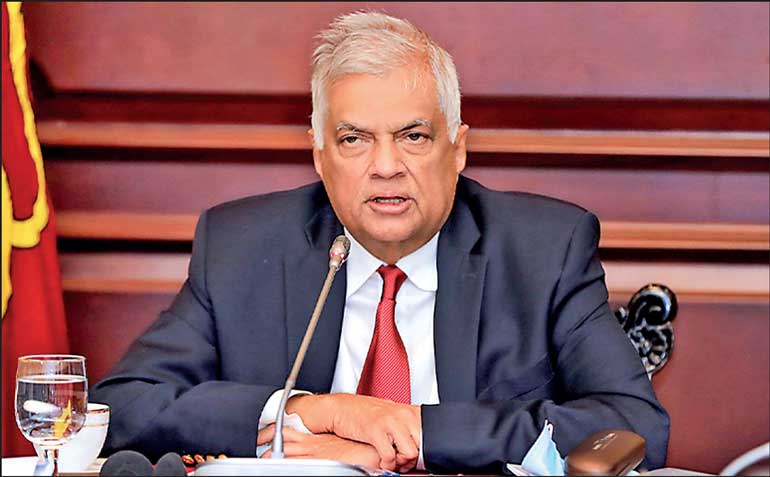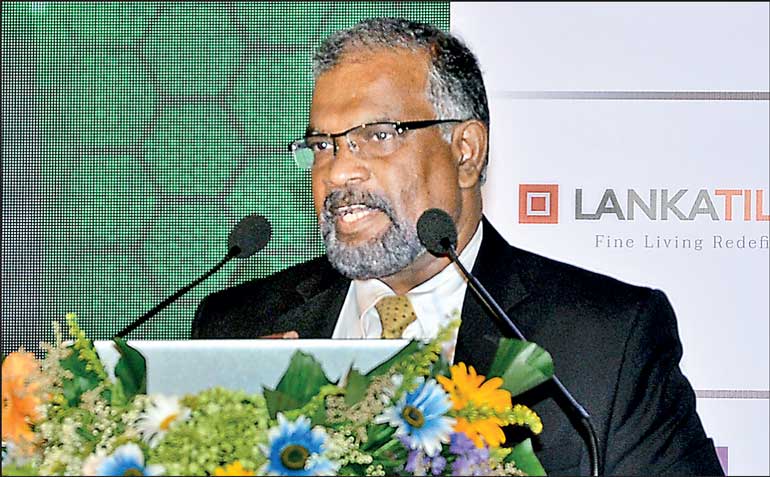Saturday Dec 20, 2025
Saturday Dec 20, 2025
Thursday, 6 June 2024 00:26 - - {{hitsCtrl.values.hits}}

President and Finance Minister Ranil Wickremesinghe

Treasury Secretary Mahinda Siriwardana
 A recent press statement issued by the Ministry of Finance dated 27/05/2024, appears to be a belated focus possibly due to an intervention initiated by an external authority. It pronounces a scheme designed for the implementation of reforms for State Owned Banks.
A recent press statement issued by the Ministry of Finance dated 27/05/2024, appears to be a belated focus possibly due to an intervention initiated by an external authority. It pronounces a scheme designed for the implementation of reforms for State Owned Banks.
The diagnosed defects to be addressed are in summary form as follows;
It is public knowledge that these defects have been in existence over a long period unnoticed or ignored by authorities. Hence the sudden provocation to address them hurriedly and announce even before many other processes that have to be accomplished corollary to this move are in place, is a matter of conjecture. The obvious guess would be to presume pressure from IMF/World Bank/Hired advisory firms and/or some such agency interested in introducing corrective measures which the normal governance has overlooked.
Direct and indirect exposures to the Govt.
The recently published balance sheets of the two major SOBs do not reflect the following position indicating the loan portfolio of the two banks and the amounts granted as loans. It also indicates that the investment portfolios too of both banks, BOC and PB are fairly large.
PB’s total loan portfolio is 1,823,770 million. And the SOE component in this is Rs. 772,611 million (42% of the total).
BOC position is, out of a total loan portfolio of 22,029,061 million SOE component is Rs. 890,252 million (40.3%).
It is obvious that the direct and indirect exposure to the Government has limited their capacity for lending to the productive sectors of the economy.
Nevertheless, the SOBs claim that they have fulfilled their profit targets while loading the balance sheets with income generated from lending to SOEs well supplementing the income on account of other normal lending operations. This shows that the returns both banks have shown as income from lending to SOEs are significantly larger compared to income from other sources.
Now this is not something that has happened overnight. For nearly a decade now bank balance sheets have shown this state of affairs as a growing visible phenomenon. The Government aided this by providing cover by the securitisation of the unpaid debts, issuing letters of comfort to help the banks keep overdue and unpaid loans in the current books of the banks without treating them as overdue/past due. This helped the banks to retain non-performing loans in the category of current active loans vicariously conforming to bank supervisory conditionalities of the CBSL without making provisions on account of loan impairments applicable to Non-Performing Loans (NPL). In turn this also helped the banks to show bloated profits in their published financial statements.
 The CBSL accepted those so-called Letters of Comfort as proper securitisations for the outstanding facilities disregarding the fact whether they came under approved/declared Government liabilities. This practice has continued for several years including the full span of the Sirisena/Ranil good governance era. That is why we are compelled to believe that these reform proposals appear to have originated under some external influence.
The CBSL accepted those so-called Letters of Comfort as proper securitisations for the outstanding facilities disregarding the fact whether they came under approved/declared Government liabilities. This practice has continued for several years including the full span of the Sirisena/Ranil good governance era. That is why we are compelled to believe that these reform proposals appear to have originated under some external influence.
Capital adequacy of PB and BOC
Historically the Treasury has been providing funds for achieving capital adequacy standards for both banks. The process started in the early 1990s following the highly controversial declaration of insolvency of the banks by the then Minister of Finance. In this instance the two banks ran a capital shortage of Rs. 23 billion to comply with the international standards. The Treasury pumped in funds to make them adequately capitalised by issuing long term interest bearing bonds.
The Treasury imposed certain conditions on the banks during this exercise through agreements separately signed with each bank. Treasury afforded the two banks a certain degree of autonomy to give them a free hand to compete with the industry private sector freeing them from some provisions of the FR and AR regulations. The Treasury was inclined to create a level playing field for the banks to engage in business activities more competitively while serving to achieve their primary objectives.
But the subsequent events prove that the situation continued unabated and the Treasury had to recapitalise the banks now and again on many occasions. The drifting away from the main objectives also continued with hardly any monitoring or supervisory follow up.
The first re-capitalisation exercise entailed inter-alia, future safety measures which no one seems to have taken seriously. The autonomy granted was hardly used to achieve the broad objectives. Instead, it led to a liberalised era of self-serving to increase the fringe benefits and employee privileges in an unprecedented manner. There were conditions such as the responsibility of the directorates to be personally answerable if the capital adequacies again fall below the expected norms.
In the current scenario, the two State banks have once again fallen into a worse mess requiring an unprecedentedly huge capital infusion for their survival. It has to be understood that this precipitation cannot be solely attributed to lending to the State sector because there are a large number of loans granted to the private sector that too have fallen into the non-performing category. The Government is not responsible for this state of affairs which continues to be closely guarded by the management under various ruses.
Regulations alone cannot rectify this state of affairs. If the monitoring and supervisory roles are inactive the legacy shall continue.
Risk mitigation measures and weaknesses in governance
This is one area where the State banks have shown very poor performance. In several instances corruption and callous disregarding of accepted norms have been so rampant with hardly any intervention from regulatory authorities. In one of the two major SOBs a Director also serving as the Chairman of the Board Sub Committee went on a campaign of self-serving his group of companies with hardly any realisable securities ending up with alarmingly high balances going up to Rs. 12 billion figuring in the NPL category of that bank. Machinery offered as security are found to be non-existent.
While there is concern and focus on the provision of financial assistance to the more sectors of our economy, the State bank has proceeded to grant a facility to grow sugarcane in Sierra-Leone. The irony is that this State bank released $ 15 million for this project which several officers down the approving line refused to join in the approval process due to the inability of ascertaining the utility if funds granted for the purpose.
The same State bank has granted $ 10 million for a hotel project in Maldives and it was reported that not a single instalment of this facility was repaid and the litigation process also hampered due to incomplete documentation.
This establishes the need to address the risk control and risk management functions of the SOBs more closely and systematically. Entrusting the Public Enterprises Department to undertake the responsibility for managing the SOBs looks a positive step because previously although conditions were in place there was no dedicated body for oversight and monitoring.
With regard to the Audit function more stringent measures should be put in place. Even now the bank audits are conducted engaging private audit firms within the purview of the scope of the Auditor General. But history reveals that despite audits conducted over periods of many years SOBs carried large and alarming portfolios of questionable operations and financial deals like what happened in 1992.
Two international audit firms were assigned the task of conducting a complete audit and the two banks were found to be undercapitalised when the normal norms were applied which continued unnoticed over long periods before. The selection of auditors should not be allowed to the banks to decide even with the consent of the AG. It is the shareholder who should bear the responsibility of appointing and selecting auditors.
More than any of these the role of the SOBs should be monitored and assessed in the context of their principal objectives. Bank managements usually serve more profitable areas in their own interests.
Today there is a serious social issue in association with the cooperative movement of the country. The People’s Bank was set up for the primary objective of serving the Cooperative sector and the rural agricultural community. It was the primary task of the PB to operate the rural banking system and financing the MPCS movement. Many are not aware that both these sectors are facing a heavy and serious crisis all over the country. The rural banks under the MPCSs are saddled with huge financial liabilities not being able to service the depositors. The Total out standings run into several Billions. Some MPCSs are contemplating the sale of fixed assets to service the depositors.
This state of affairs is totally due to the withdrawal of the PB from playing their role in the Cooperative movement and in particular the rural banks which were run under close supervision and control of the PB. An ongoing Parliamentary Select Committee is examining this matter currently and the revelations made before them are extremely alarming in the National Context.
Appointing fit and proper persons as Directors of the SOBs is another important matter in the current context. SOBs should not be allowed to derelict their responsibility and duty to serve the rural sector enhancing the financial inclusion in these sectors by balancing their portfolios towards these primary objectives. There are instances where persons have been appointed to the directorates overlooking their past involvements in the financial sector like serving in questionable finance companies. It has been found that they have carefully maneuvered the fit and proper eligibility requirements by resigning from those places. Hence the fit and proper criteria should be an exhaustive process carefully scrutinising their past performances and involvements.
Anyway the contemplated reconstitution of SOB boards is a needy move.
The press statement refers to a number of other corollaries that have to be in place for its implementation such as the forthcoming Public Finance Management Act, the appointment of a Financial Sector Crisis Management Committee, the establishment of a specialised unit under the Public Enterprise department, new guidelines to be issued by the CBSL for governance of SOBs, Committee for Selection to be established under the Ministry of Finance to recommend nominees for appointment as SOB directors, etc. etc.
Finally, it has to be stated that SOBs were subject to adhere to new plans previously too on several occasions. But the outcome has proved to be only disastrous. We will await with fingers crossed to see what the current proposal will bring about.